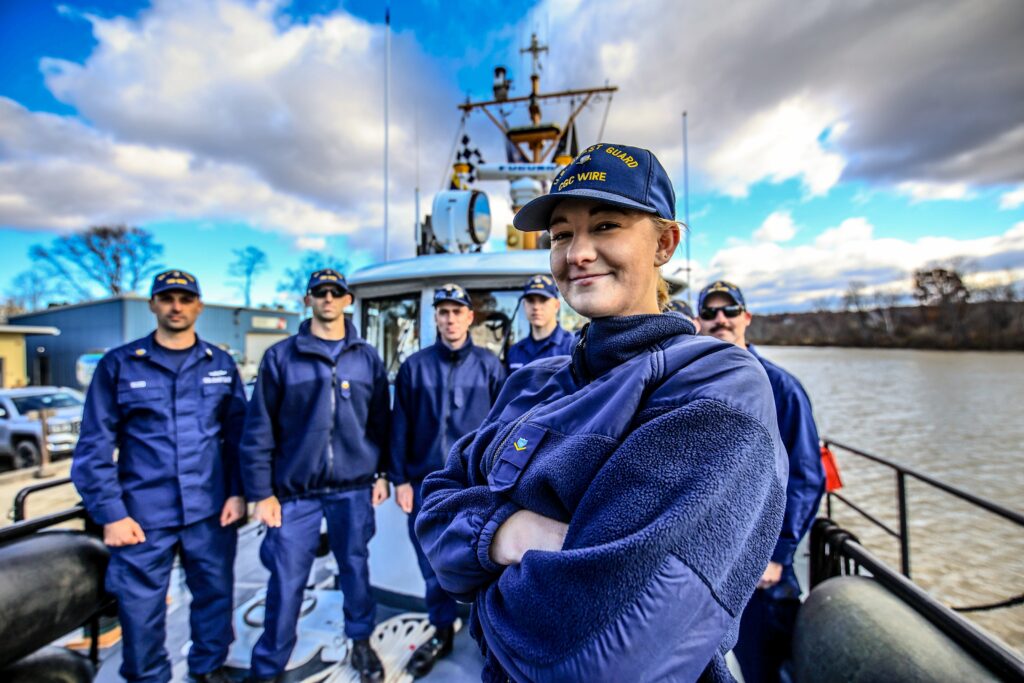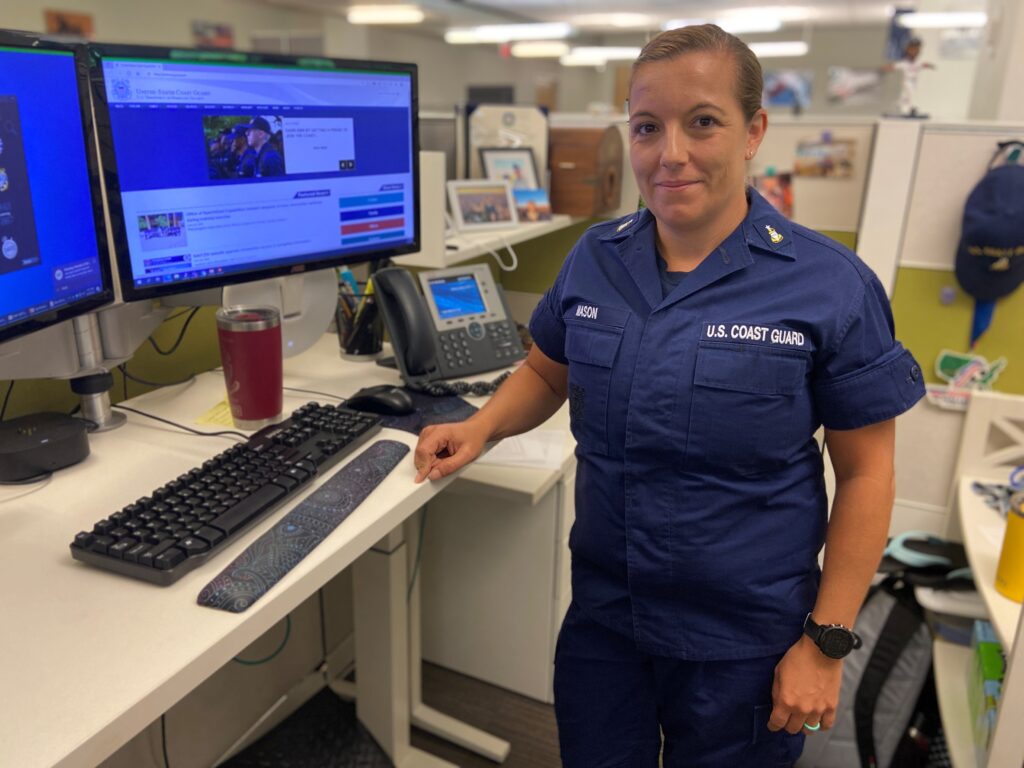
On June 1, the Coast Guard made history with the ascension of Adm. Linda Fagan to its top position as commandant, relieving outgoing commandant Adm. Karl Schultz. She took over as the first woman to head the Coast Guard and the first woman to head any U.S. military service.
Fagan arrived at that position at a time when there are still a few Coast Guard cutters afloat where women can’t serve due to a lack of rack space. That’s an issue the service has been working to eradicate for years and is on the cusp of doing so, a move expected to help boost women’s careers in the service and increase retention.
Of the service’s approximately 260 cutters, only 50 are male only, according to the Coast Guard, and those cutters are slated to be replaced. All new cutters coming online are able to accommodate male and female crewmembers.
“With the modernization of our fleet, that will all be taken care of. All the newer cutters are being built with mixed crews on board in mind,” said Senior Chief Petty Officer Ramona Mason, the enlisted women afloat coordinator at Coast Guard headquarters in Washington, D.C. “All these new ones are already mixed-gender berthing.”
Even before all the cutters are ready, “We have gotten extremely creative, to create more opportunities for female enlisted members to serve underway,” she said.
“With all these creative ways that we have come up with, our afloat numbers for enlisted women afloat has gone up. We have way more females serving on afloat platforms now than we ever did before, and the numbers have gone up every year,” Mason told Seapower. “And it’s all because they are choosing, they wanted to go afloat. We’re giving them the opportunities now.”
“Today more women are remaining in our service longer,” Schultz said in his annual State of the Coast Guard speech in 2022. “Today we have 375 more women in the service at the critically important E6/E7 and O-4 mid-grade leadership ranks than we had five years ago in 2017… that’s a 28% increase of women at these mid-career pay grades, and a trend that outpaces their male counterparts.”
He also said the service is “making progress” on the acquisition of 30 Waterways Commerce Cutters, tenders that will maintain 28,000 aids that mark more than 12,000 miles of navigable inland waterways.
“And, for the first time in history, our entire inland fleet will be able to accommodate mixed-gender crews, providing all junior enlisted members these unique afloat experiences,” Schultz said.
President Joe Biden spoke at the Coast Guard change of command ceremony when Fagan took the service’s top spot.
“When Admiral Fagan commissioned in 1985, only five years after the first women graduated from the academy, she was one of just 16 commissioned female ensigns — only 8 percent of her graduating class. She was the only woman aboard Polar Star for the first set of orders,” Biden said.
“Currently, the Corps of Cadets at the Academy — more than 1,000 cadets strong — 40 percent are women.
Forty percent are women.”
Even as more women enter the service, keeping them there can be a challenge.
A recent study by the RAND Corp., “Why Do Women Leave the Coast Guard, and What Can Be Done to Encourage Them to Stay?” listed a variety of issues that answered the title question, among them the lack of berthing.
“Female focus groups cited issues with advancement, including the perception of bias in subjective evaluations, as influencing decisions. Furthermore, participants noted that berthing restrictions for women can limit opportunities,” the study says.
Mason said it’s important to provide as many afloat opportunities as possible to female Coast Guard members, as it can affect their career.
“Certain rates have requirements that you have to have a certain amount of years afloat, so it is a requirement for advancement. It’s a requirement for certain ratings or certain competencies that you can only earn afloat,” she said.
And while anyone in the Coast Guard can go afloat at any point in their careers, and are encouraged to do at least one tour afloat, “in order for advancement, in certain rates you have to receive the afloat time at a certain point in your career,” she said.
Making even smaller Coast Guard cutters able to accommodate mixed crews has other benefits that can aid in retention, Mason said.
“We’ve opened up a lot of the smaller cutters with enlisted females, which have always been in higher demand for the females due to the shorter underway time and the family life you can have when you’re only away for two to three weeks versus two to three months,” she said. “With us opening the smaller space to females, it has helped with retention, because they now see they can get under way on small platforms and not be such a family burden.”

Making Room
Part of Mason’s job is to find room on Coast Guard cutters for women even if they aren’t designed with separate living quarters. She does that by sometimes repurposing space.
In a 2021 post to the Defense Visual Information Distribution Service, Chief Petty Officer Ryan Burger recounts how he got a call from Mason after he was appointed officer in charge of the Coast Guard Cutter Wire, a 65-foot ice-breaking tug. She asked if he could accept a female Boatswains Mate Third Class. He said yes. When she asked if he could accept another female as well, he said they had to do some work.
They ended up removing a convertible fold-out rack that had been used for executive petty officers and revamping it to hold two racks. They then proceeded to make a similar change to two other 65-foot cutters operated by Sector New York.
“We’ve assigned women to these cutters in command cadre positions in the past, however, assigning a third-class boatswains mate aboard is new,” Mason told writer Daniel Henry. “For the first time, a woman in a non-command position has received orders to the Coast Guard Cutter Wire.”
Petty Officer Third Class Hailey LaRue, a boatswains mate who was then able to serve on the Wire and reported there in the summer of 2020, said the move broadened the learning opportunities available to her, which wouldn’t have been possible on the 87-foot cutter she had served on previously.
“I knew I wanted to go afloat out of A-school to get rated sea time so that it would help me in my future career,” LaRue said. “It’s smaller and it’s a tight knit crew. There are tons of learning opportunities on both deck and engineering side so you’ll become a better-rounded individual in your [rating]. There are opportunities you’ll get here that you won’t necessarily get on a bigger cutter where you’re focused on a specific area.”

Cmdr. John Singletary, Chief of Waterways Management for Sector New York, told Henry, “providing this mixed gender berthing gives those members the opportunity to start their careers out early. They get to lead as a BM3 or a BM2. Eventually that path will lead to XPO positions on the new waterways commerce cutters that are being commissioned in late 2024.”
Not Just Afloat
The need to create berthing space for female Coast Guard members isn’t just for the water. In late September 2021, Coast Guard Station Morro Bay in California, part of Sector Los Angeles/Long Beach, made such an addition, according to the Coast Guard.
The station is home to 27 Coast Guard members and two 47-foot motor life boats. The station constructed a one-story, 806 square foot addition to the existing facility, creating room for up to six additional crewmembers and allowing overnight duty crews to be made up of men and women.
Women had been assigned to Morro Bay previously, but couldn’t always be accommodated for some of their duties due to a lack of berthing.
“We needed a dedicated accommodation for [women] and we now have that with the building expansion,” Petty Officer 1st Class Joshua Sheppard said in a My CG blog post. Women “can now be completely integrated as a member of the unit without being excluded from missions or opportunities and without posing a significant burden to the operational readiness.”
Mason wasn’t part of that effort — her duties extend only to women who serve afloat — and said the part of her job devoted to finding female berthing is coming to an end as the Coast Guard continues its modernization.
“The coordination part will go away, but the advocacy for women afloat will stay. My job is somewhat more transitioning into a women afloat career counseling position as well,” she said.
“I do year-round career counseling with all the females in the Coast Guard that are interested in afloat assignments,” working on resumes and timetables for them to go afloat, “when should they get underway, when do they have to get underway.
“So, the counseling part will stay around for the enlisted women of the Coast Guard.”




